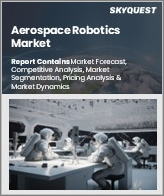
항공우주 로봇 세계 시장 규모는 2023년 25억 달러, 2024년 27억 8,000만 달러에서 2032년에는 65억 달러로 성장하고, 예측 기간중(2025-2032년)의 CAGR은 11.2%를 나타낼 전망입니다.
항공우주 산업은 자동화를 추진하고 있으며, 수작업과 인적 오류를 최소화하는 로봇 통합을 통해 비용을 낮추면서 생산성을 크게 향상시키고 있습니다. 이러한 기술 혁신은 빠르고 정확한 생산 공정을 촉진하고 세계 항공우주 로봇 시장의 큰 성장에 기여하고 있습니다. 항공기 조립에 로봇 무리를 배치하는 것과 같은 혁신적인 접근 방식은 이러한 추세를 잘 보여주고 있으며, 속도, 비용 효율성, 정확성을 향상시킨 대형 항공기 구조물 건설을 가능하게 하고 있습니다. 경쟁이 치열해짐에 따라 항공우주 기업들은 비용 절감, 효율화, 제조 공정의 간소화를 위해 로봇 솔루션의 채택을 늘리고 있습니다. 궁극적으로, 자동화 기술을 활용함으로써 이들 기업은 생산성을 최적화하고, 실수를 줄이고, 자원을 절약하고, 시장에서의 입지를 강화할 수 있으며, 이는 항공우주 제조 전망에 있어 획기적인 변화를 강조하고 있습니다.
Global Aerospace Robotics Market size was valued at USD 2.5 billion in 2023 and is poised to grow from USD 2.78 billion in 2024 to USD 6.5 billion by 2032, growing at a CAGR of 11.2% during the forecast period (2025-2032).
The aerospace industry's push for automation is significantly enhancing productivity while lowering costs, driven by robotic integration that minimizes manual labor and human error. This technological innovation fosters rapid, precise production processes, contributing to substantial growth in the global aerospace robotics market. Innovative approaches, such as the deployment of swarms of robots for aircraft assembly, exemplify this trend, enabling the construction of large aircraft structures with improved speed, cost efficiency, and precision. As competition intensifies, aerospace firms are increasingly adopting robotic solutions to achieve cost savings, greater efficiency, and streamlined manufacturing processes. Ultimately, leveraging automation technology allows these companies to optimize productivity, reduce errors, conserve resources, and bolster their market presence, underscoring a transformative shift in the aerospace manufacturing landscape.
Top-down and bottom-up approaches were used to estimate and validate the size of the Global Aerospace Robotics market and to estimate the size of various other dependent submarkets. The research methodology used to estimate the market size includes the following details: The key players in the market were identified through secondary research, and their market shares in the respective regions were determined through primary and secondary research. This entire procedure includes the study of the annual and financial reports of the top market players and extensive interviews for key insights from industry leaders such as CEOs, VPs, directors, and marketing executives. All percentage shares split, and breakdowns were determined using secondary sources and verified through Primary sources. All possible parameters that affect the markets covered in this research study have been accounted for, viewed in extensive detail, verified through primary research, and analyzed to get the final quantitative and qualitative data.
Global Aerospace Robotics Market Segments Analysis
Global Aerospace Robotics Market is segmented by Robot Type, Component, Payload, Application and region. Based on Robot Type, the market is segmented into Traditional Robots and Collaborative Robots. Based on Component, the market is segmented into Controller, Sensors, Drive and End Effector. Based on Payload, the market is segmented into Up To 16.00 KG, 16.01-60.00 KG, 60.01-225.00 KG and More Than 225.00 KG. Based on Application, the market is segmented into Drilling & Fastening, Non-Destructive Testing & Inspection, Welding & Soldering, Sealing & Dispensing, Processing, Handling and Assembling & Disassembling. Based on region, the market is segmented into North America, Europe, Asia Pacific, Latin America and Middle East & Africa.
Driver of the Global Aerospace Robotics Market
The global aerospace robotics market is driven by manufacturers integrating advanced robotic technologies into aircraft to improve efficiency, precision, and overall quality in response to the revival of international air travel and a rise in aircraft production. Robotics streamline various processes such as assembly, drilling, welding, and inspection, significantly reducing both manufacturing time and human errors. As original equipment manufacturers and suppliers prioritize shorter production cycles, enhanced throughput, and cost efficiency, the adoption of robotic systems is becoming more prevalent in the aerospace sector. This demand is fueling growth in the aerospace robotics market as the industry evolves to meet current challenges.
Restraints in the Global Aerospace Robotics Market
The Global Aerospace Robotics market faces specific challenges, particularly for small and medium-sized enterprises (SMEs). These companies often struggle with the significant expenses associated with acquiring and implementing aerospace robotic systems, as well as the costs of training personnel and integrating new technologies with existing legacy systems. Such financial burdens can deter the adoption of advanced robotics, especially in regions where the aerospace industry is underdeveloped or lacks adequate government support. Consequently, these obstacles may hinder broader integration and utilization of robotics within the aerospace sector, limiting innovation and competitiveness in the market.
Market Trends of the Global Aerospace Robotics Market
The Global Aerospace Robotics market is experiencing a significant rise in the adoption of Collaborative Robotics (Cobots), driven by the need for enhanced operational efficiency and safety in aerospace manufacturing. Cobots are designed to work alongside human personnel, facilitating tasks such as material handling, surface polishing, and real-time quality inspections. Their adaptability allows for quick reprogramming, making them ideal for high-mix, low-volume production environments typical in the aerospace sector. As manufacturers increasingly prioritize flexibility and precision, the integration of cobots is set to redefine assembly line processes, positioning the aerospace robotics market for robust growth in the coming years.